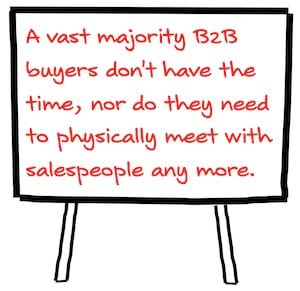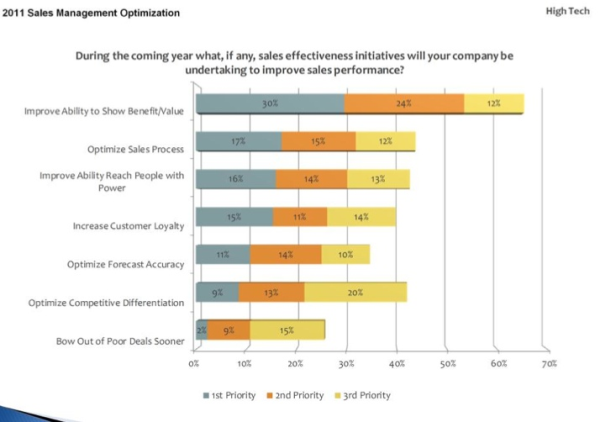This article is relevant for B2B technology sales professionals, not just inside sales, as we are all becoming more virtual in our engagement with prospects and customers.
Findings from the
CSO Insights 2011 Telemarketing/Inside Sales Performance Optimization survey set the stage for our conversation. The big Aha in the 2011 survey is that
nearly 50% of inside sales are selling independent of field sales.
Inside Sales - No Longer a Junior Partner
The perception of inside sales as the junior partner, being confined to lead-gen, appointment setting and qualifying is changing, as inside sales increasingly handle the complete sales cycle and create trusted adviser relationships with clients. Soon this will become the dominant mode of selling.
Inside Sales Effectiveness Focus in 2011
Inside Sales Priorities
Once again the top priorities for sales leaders in the CSO Insights survey are to align sales and marketing and to increase lead generation.
These two objectives are inextricably linked, only in my view, sales leaders have them in the wrong order and I propose the following priorities.
1. Sales and Marketing Alignment
- As a first step, we need to align sales and marketing messaging around product usage and value creation; features and benefits selling is dead and most marketing teams have work to do to translate features and benefits ("product-speak") into something the sales team can actually use to engage prospects.
- Aligning sales and marketing also means agreeing on the definition of what makes a sales-ready-lead. Innovative companies like HubSpot have established service level agreements between marketing and sales and both groups are tightly aligned in their objectives.
2. Enhancing Lead Generation
Once you’ve established a
value proposition that is built on product usage and value creation, you have something that both sales and marketing can use. Creating content that prospects value attracts interested visitors to your Website; engages and converts them into leads using an Inbound Marketing process.
David Baga
I spoke to
David Baga, VP Sales at hot SFO-based
RocketLawyer last week about his challenges in running a rapidly growing inside sales team. (RocketLawyer is a fast growing startup designed to make legal services easy and affordable for individuals and SMBs)
"The #1 challenge is connect rate....getting the prospect on the phone is becoming increasingly difficult. Cold calling is virtually impossible in today’s environment and would be a crude waste of time and money compared to an inbound marketing engine.”
Inbound Lead Generation Requires a Technology Foundation
Baga continued, “We need interested prospects to raise their hand and Inbound Marketing platforms like Marketo and
HubSpot make this possible and the performance predictable.
Our lead generation is dependent on an integrated technology fabric consisting of:-
• Inbound Marketing Automation platform (Marketo)
• CRM systems (Salesforce.com)
• Cloud-based call center technology with predictive dialers, ACD (auto-dialers), IVR (Interactive voice response) (Five 9’s)
Putting this stuff together and delivering the right content at the right time is hard to do; we’ve been at it 9 months now and are just beginning to realize the benefits of our efforts”
3. Revising Sales Team Structure.
There is a perception in sales that inside sales earning potential is limited. This is no longer the case and it is possible to achieve income parity with outside sales reps in many inside sales positions.
“We have chosen to centralize our sales team so that we can provide them with technology, education, collaborative support and sales management needed for high productivity. The productivity gains alone make it advantageous over individuals working out of a home office”, added Baga
Salesforce.com, like RocketLawyer and HubSpot have created very successful, centralized inside sales teams. Salesforce.com has created various roles and specializations for their inside sales team to provide a career path for advancement and to lower customer acquisition cost.
A typical Inbound Sales team structure is;
• Lead Development – work inbound leads, responsible for lead qualification, pass lead on.
• Small Business Representatives - quota carrying, responsible for a territory
• Account Executives - responsible for major accounts; travel from time-time to meet customers
4. Revising Sales Process
BANT - Discovery and Qualification, the Achilles heel of selling.
If salespeople spent less time talking about their products and more time listening to the buyer's answers of their insightful questions, they would improve their diagnosis of the client condition.
Without a strong qualification process like
BANT, underpinned by skilled diagnosis and discovery, pipeline reviews and forecasting are a magical and mystical event.
Using a whiteboard to Create Buyer Vision
On the minus side,
inside selling means salespeople must work harder to develop rapport because the visual dimension is missing in the communication feedback loop.
The good news is that there are new tools that can really help in creating a dialogue and engaging the buyer around their issues. My WhiteboardSelling customers are spread across the World and 95% of my sales calls are virtual. I prefer to sell this way now.
Using the
Paper-Show digital whiteboard and GotoMeeting or Webex videoconferencing service enables me to engage buyers in a whiteboard discovery session and present our approach to the prospect’s sales and marketing challenges using a whiteboard and to gain excellent feedback at every transition in the process.
I follow up the meeting with a
qualification confirmation letter with the whiteboard from our session embedded as a .jpeg in the letter. This has a huge impact on forecasting accuracy as the qualification confirmation process eliminates non-buyers at the outset and makes it much easier for your mentor or internal champion to build and position your case against competing projects.
5. Facilitating a Buying Process.
Shift in Power in the Buy-Sell Equation.
The relationship with buyer has shifted from managing the sales process to facilitating a buying process…prospects buy when they are ready to buy.
“We spend a lot of time and effort with our middle funnel process generating relevant information that maps to buying needs/process once the visitor has converted into a lead by completing a form.
With the buyer in control, lead nurturing is essential to manage and establish a trusted relationship and stay top of mind until the buyer is ready and to measure online behavior and interaction. Leads are scored based on activity and routed to sales at the right time.” said Baga.
Take Aways:
1. Sales and Marketing alignment is step 1 on the journey to improved sales performance for Inside sales.
2. Inbound Marketing underpinned by a tightly integrated technology fabric is no longer an option – it's essential to Inside Sales Success.
3. Lead nurturing is the way to stay top of mind and build a relationship with prospective customers until they are ready to buy.
4. Skilled whiteboarding can restore the communication imbalance in a virtual environment.
5. You don’t have to sweat closing deals if you have done your job in discovery and qualification.












